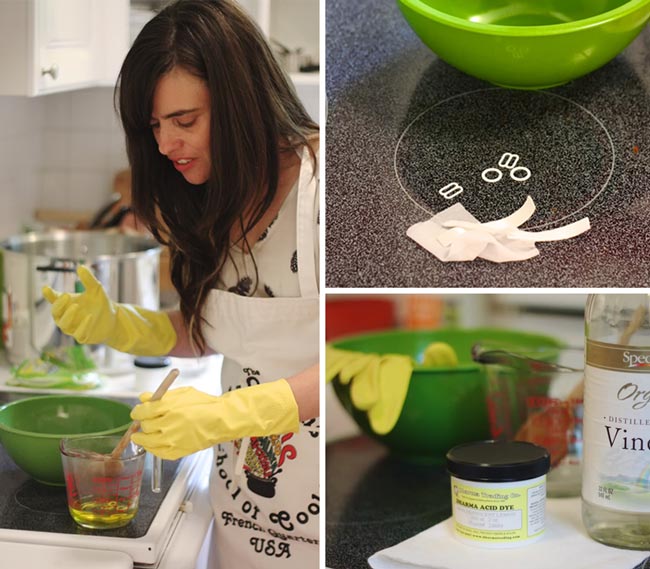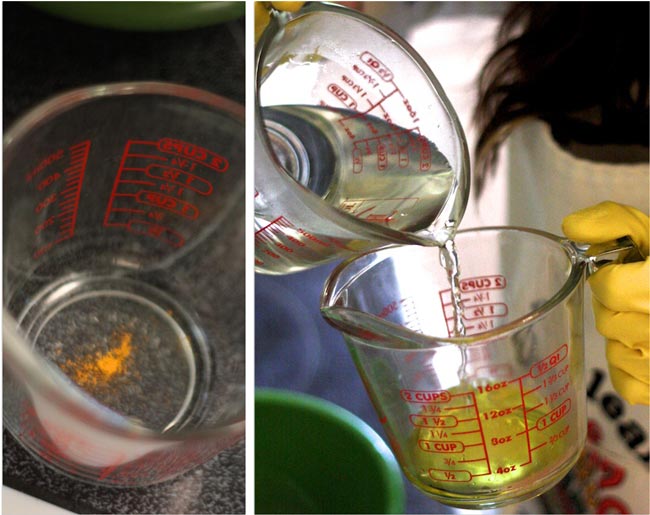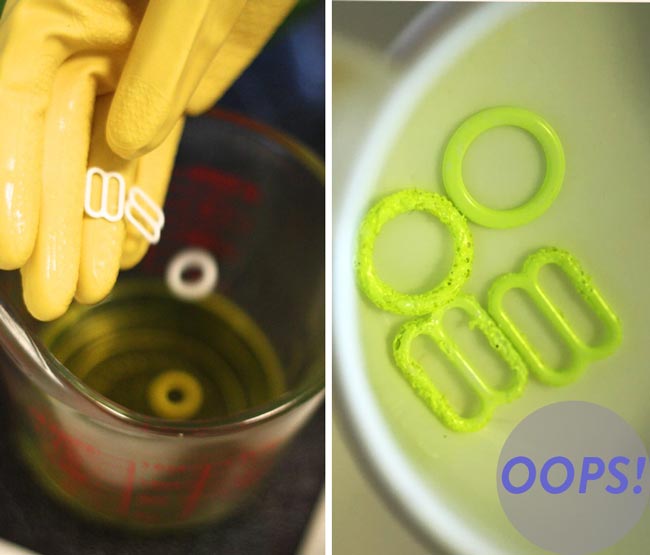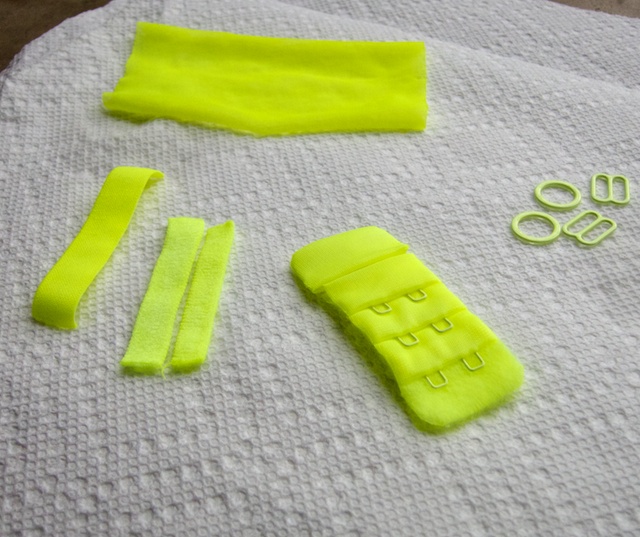It’s been awhile since my last Lingerie Friday! We are still settling in and finding new rhythms after what feels like eons of moving and sorting and unpacking. This week I’ve been dreaming up color ideas for future lingerie projects, and so I’ve been playing around with dyes again. I never aspired to be a painter, but I went through a phase where I was completely taken with mixing paint colors. I would spend hours mixing watercolors and gouache to get exacting shades of olive, lilac, pale pale coral. It was inevitable that I’d fall for dyeing, and I have fallen hard.
I’m dreaming about yellows at the moment, specifically lemon-y or acid yellows so I’ve been experimenting with a few dyes. My friend Stephanie came over and took some photos of me in the “lab”.

Ingredients: Dharma acid dye in “Fluorescent Lemon”, vinegar, hot water. For the small amounts I am dyeing, I use a Pyrex jar. Don’t forget the gloves and “not-for-cooking” spoon.
What I’m dyeing: bra rings & sliders, hook & eye, and a few samples of elastic and stretch mesh. I wash these in a mild soap to remove any residue. (You never know; some fabrics have surface treatments.)
Before I commit to larger amounts, I’m dyeing just these little bits to see how it turns out. A teensy bit of powder dye goes a long way for so little… even a sprinkle is almost too much. I add the hot water to the dye…

The nylon-coated rings take the longest to accept dye. They usually sit and take on barely a pale stain until I add the vinegar. The water has to be hot. They tend not to dye well if the water doesn’t stay hot. If I’ve already added vinegar and they’re still being stubborn, I take the rings out and microwave the dye water to heat it up a bit.

Oops, here’s what happened when I didn’t take the rings out before re-heating the water in the microwave. Melted nylon!
The rest of my samples seemed to take mere seconds. I used to pull fabrics out and rinse them as soon as they got to the intensity I wanted. But I’ve since learned that the time in the acidic hot “bath” is also important to how colorfast the dye will be. I’m still experimenting, but if there is still some dye left and I don’t want the notions to take up any more, I transfer them to another pot/jar with just hot water and vinegar for about 20-30 minutes.

Since I had a bit of dye left, I threw in another set of rings and sliders to make up for my melted ones. This lemon is super neon! (It really does glow in the dark.)

Note that I’m dyeing nylon (and my elastic is nylon), so I’m using an acid dye. You can also use RIT, as it contains a form of acid dye along with another type of dye for cottons and such. With either an acid dye or RIT, the heat and acidic pH (via vinegar) are the key to encouraging the dye to bond and this works for nylon as well as silk. I love the “professional” acid dyes. They’re much less expensive than all-purpose dyes and the colors are more brilliant and predictable. I still happen to have a bottle of RIT not-fluorescent “Lemon” waiting for my next experiment…
Happy colorific lemon-y weekend everyone!
x
Would you like tips and inspiration in the craft of lingerie sewing? Sign up for my weekly eletter The Lingerie Maker.

Very, very cool! I had no idea you could dye the notions. I didn’t think anything like that would take dye. Where do you get the professional acid dyes at?
Hi Jill, acid dyes are fairly easy to find, but not as common as Rit. I’ve seen Jacquard (brand) acid dye in my local Joann’s. The ones I use are from Dharma Trading, including the dye I used here. Maybe professional was the wrong word? I wasn’t sure how to distinguish them from all-purpose dyes.
This looks fun. I have never had a lot of luck with dyeing…I am curious about the Dharma acid dyes as I have seen a few bloggers use these to great effect. Looks like a groovy bra in the making!
It is going to be very groovy! Have you tried other acid dyes? I’ve used Jacquard and also want to try a few other types. This store in Australia seems to carry a lot of different acid dyes. I’m curious about the fast-milling types. I read somewhere that they are particularly good for nylon. With the small amounts that I’ve been dyeing it’s been really easy, but I’m starting to commit more yardage so I’m really trying to do my research. I think of it like baking, it’s a lot of measuring and kitchen mess at first, part science part art. Baking’s almost worse. I make a mad mess…
This is an excellent dyeing tutorial. I haven’t tried dyeing the lingerie trimmings yet, and our colour choices here are soooo limited, I really will have to give this a go! Thanks for the inspiration.
Oooh so cool! I’ve always wondered about dyeing those little bra sliders! And that color is… just… wow!
Nice post, i will share with my friends.
…and I was only just looking for fluoro yellow picot to no avail. Great tutorial Amy, bookmarked! Imagine, black mesh with fluoro trimmings? ahhh I DIE!
That’s pretty close to what I’m making :).
Ooh that looks so much fun…
Thanks for the vinegar tip. I was having a hell of a time getting the notions to dye, but I was just using drugstore dye so maybe that is why? (I’m a poet, and i l know it) I’ll have to mess around some more once I stop making bathing suits non stop…
Sigh, elastic that won’t dye… (I tried!). Was it RIT? That should dye your stuff if it’s nylon. Perhaps it was the fiber–sometimes lingerie elastic has polyester content and not nylon. I had a couple of frustrating dyeing experiences last fall and I realized that my elastic had a lot of polyester content. If it’s just staining or only part of it is dyeing, or none of it, changes are it is mostly polyester. Try bringing it slowly up to heat, and about 10 minutes in add your vinegar. You’ll watch color start to get intense quickly after that–hopefully!
Wow. Now that’s yellow!
Bra making is taking a back seat right now as I work on the jumper pattern but after I finish, I’m diving back in full steam! No joking around this time (reading Norma’s book, etc). I have yet to dye notions – I’m still working on fitting/construction techniques but I know the time will come where that will be the next thing for me to learn. Bookmarking this until then.
P.S. – love seeing a chemist in her lab 🙂
What about using a tiny crockpot for keeping the notions warm? Acid dyes dye nylon and protein fibers, what about using Mx dyes(used for dyeing cottons rayons and other cellulosic fiber) but which can dye protein fibers with vinegar instead of salt. Would this work on nylon? The advantage is that you can dye in a baggy without using heat. I’m intrigged. I do a lot of dyeing and want to try this out.
Hi Theresa – what Louisa said ;). Here is some helpful info on dyeing nylon. Under the heading “fiber reactive dyes”, she indicates that without the lower pH and heat, nylon will probably just “stain”. I have yet to try!
Ohh and thanks for the idea of sticking my pyrex in a crockpot! Sorta like a double boiler. The microwave is kinda intense.
Thanks for doing the experimenting for me, Amy! I’ve dyed the hooks & eyes before as well as powernet and the elastics but not the rings and sliders. Good to know that they will melt at too high a temp!
Theresa, as you mention Procion MX works as an acid dye with vinegar but you still need some heat just as for regular acid dyes. It’s cotton (and other cellulose fibres) that need the cooler temps with soda ash.
BTW, food colouring, Easter egg dyes and unsweetened Kool-Aid drink mixes are also acid dyes. In case you don’t have the “professional” dyes handy to test!
Thanks for the tips, Louisa. I’d definitely dye the rings separately because they are tricky to monitor with everything else in the same pot (hogging all the dye). I probably should’ve used thermometer to find out exactly what’s too hot! The trick is definitely keeping it hot when using a pyrex and not something on the stove. And thanks for the info on the Procion dyes. I just dyed a bunch of cotton and I’m curious about its brilliance on nylon.
You inspire me so much! I’d give you a hug if I were closer. I’m getting up the courage to try my own adventures in bra making because of your posts.
Wow this is so super cool! Now you can have it any colour you want. I’ll be sure to make it hot pink. Absolutely interesting!
Cheers,
Ade (www.adesays.wordpress.com)
Have you ever had a problem with the hooks darkening or tarnishing? I seem to have that problem on my last batch. I dyed two different kinds. Not sure if I used to much acid or left it in too long.
I dye in a crockpot and usually just let the fabric/notions cool down in it
Hi Natasha, I haven’t experienced that. I’m sorry to hear that happened to you! The nylon-coated metal, which is in the hooks and rings, is the hardest to dye and lately I’ve given up on all but light colors, and use silver or gold hardware instead.
I was able to get a really dark orange color on a nylon plastic rings and sliders but that was with my crockpot so maybe the time in the dye bath helped.
Hi Natasha, I just had a thought from my own dyeing experiences… Every dye color has slightly different chemical structure so some colors may be easier to achieve. Blues and turquoises are often a bit slower or need a lot of heat to really develop and bond, with either RIT or acid dye. Yellows are quite fast. When a dye has a mix of say, yellows and blues, the yellows tend to show up faster. This is why some colors can be hard with the nylon-coated metal. I get super bright colors if I bring the water to boiling and keep it there, but when I did this the nylon melted right off the rings–which you can see happened up there!
Another thing to check is your crock pot. Is it aluminum or aluminum coated? Aluminum does react with acid dyes (including RIT) so could have contributed to your odd color. This is why I use glass jars for dyeing small bits. When I’m doing bigger dyeing, I use a stainless steel pot.
Also, once the water has cooled down completely the dye is done and has done all it can do, so leaving overnight won’t help much. This makes me think that something reacted…
I hope this response helps others troubleshoot! I get a lot of questions about dyeing so I hope I haven’t overanswered *your* question!
The crock pot is actually ceramic. I originally got it when I used to hand paint a lot of fiber for spinning. For that I would heat up the water, add the acid then let the fiber soak for awhile then pour the dyes on then leave it simmering until the dye had exhausted. That was with acid dyes.
This time I was using RIT of which I’m not overfond of. I was cooking it over the stove but found the elastic curled so switched to the crockpot and that worked well. I figured out what the discoloration was though. Not rust but some of the dye settled in the cervices around the hooks so it looked darker especially being tangerine.
Was talking with Maddie a couple of weeks ago about using disperse dyes instead of acid. I know RIT is a combo of dyes including acting as a disperse at higher temps.
I’m slowly relearning dying piece by piece. So much I have forgotten.
Have you had any issues with colors bleeding? I’m having trouble finding neon picot elastic so thinking of dyeing my own but worried it’ll bleed onto the fabric I sew it to.
Hi Abby, I haven’t experienced any bleeding yet with the neon dye I used. After dyeing I wash in synthrapol to get rid of any unattached dye, but just to be safe handwash my items in cold water. Every dye color can be different, so the only way to know is test…
Thanks for all the helpful information you have posted on your site! I was wondering where you get your elastic that you know is nylon, I was looking at plush elastic and strapping elastic on sewsassy.com for bra making but it doesn’t say the content. Have you tried dying any of their elastic? Thanks!
Hi Lesley! I always ask (either call or email) the seller. Sew Sassy changes their stock occasionally so you may want to call them to make sure–very friendly staff! The last I asked, some of their plush/finishing and strap elastic had a majority of polyester content but don’t take my word as gold. (I do know for a fact that their piping elastic is nylon-based because I dye the white all the time–it’s my favorite for using as underarm elastic.)
At the moment I buy much of my strap and finishing elastic at fabricdepotco.com. I check in with them to make sure the elastic is nylon-based first (and the owner Susan will test dye for me and email back!). I know from experience that all of her strap elastic dyes very well.
I love sewing, its my passion, but sometimes I don’t find the exact colour I want, So I decided to use Dharma product to dye the fabrics. I Found your website because I want to dye a dress exactly of this colour you are using “fluo lemon”
Great job.!!!!
Hi! Where are you purchasing your nylon elastics from? Sew sassy has nylon spandex strap elastic, but their finishing elastic has polyester in it. I called dharma, they said the acid dye won’t color polyester. If I could find all plush nylon spandex elastic in all the sizes my day would me made lol.
Most of my elastics are from Fabric Depot. Bra-makers Supply also sells nylon/spandex plush types. I do get asked this a lot so I devoted a post to it! – Where I buy my supplies.
Thank you! I emailed the ladies, at fabric depot last week, they were very lovely and helpful! They directed me to all the elastics that were dyeable. I recently got my order. Thank you! I’m ordering my dharma acid dyes right now! Can’t wait!
Have you used Kool-Aid (regular, unsweetened) to dye nylon? It works great as those of you who have nylon carpeting–and kids who like Kool-Aid–know well.
You can mix Kool-Aid colors, (i.e., flavors) to get an almost endless number of colors. There are lots of tutorials for this online.
Hi Michelle, I’m familiar with Kool-aid dyeing. It works very similarly to acid dyes (the chemistry is the same). I prefer using acid dyes simply because I have more color control and it’s a whole lot cheaper by the gram. But it’s definitely something others may want to play with!